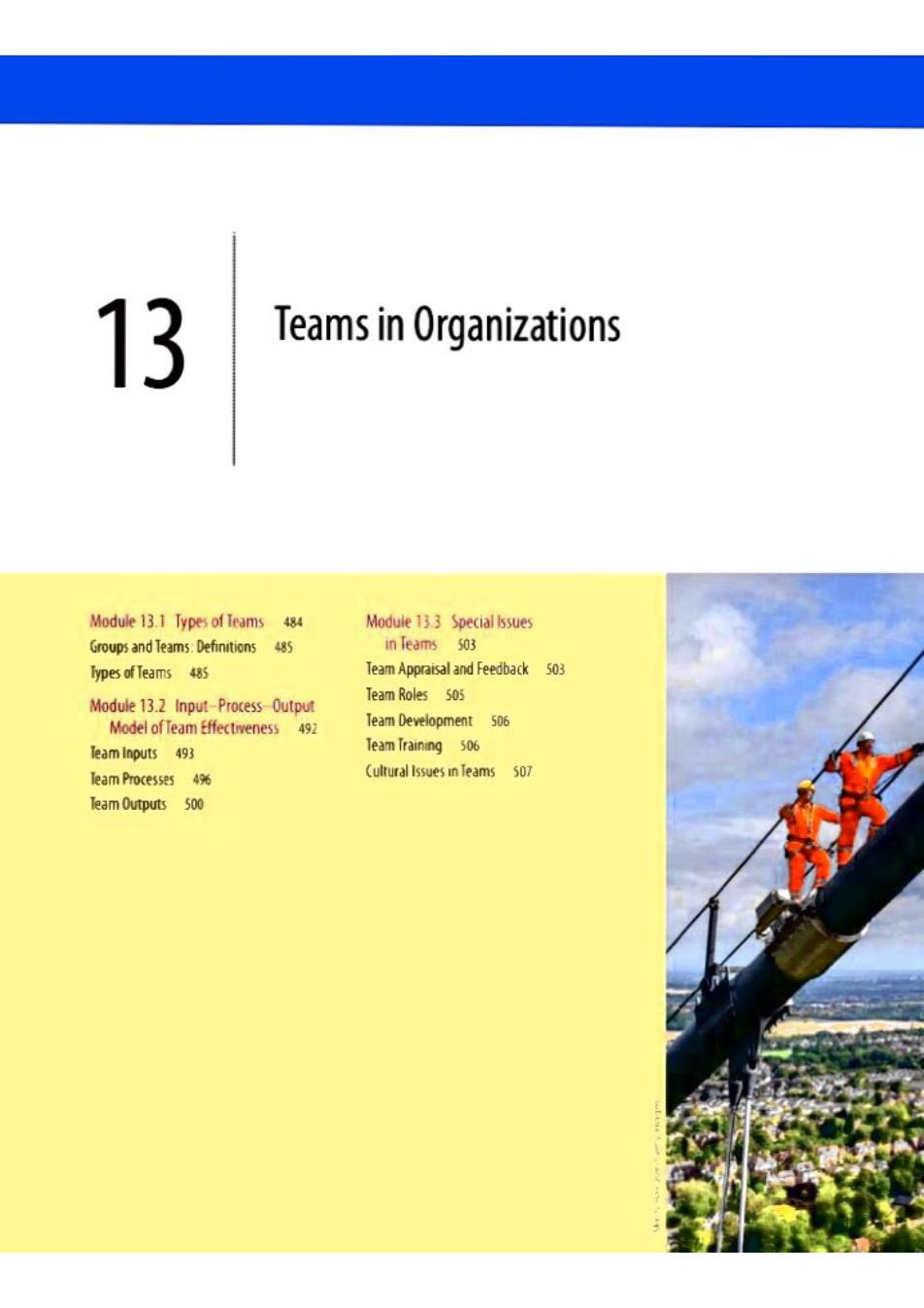
13 Teams in Organizations Module 13.1 Types of Teams 484 Module 13.3 Special lssues Groups and Teams:Definitions 485 in Teams 503 lypes of Teams 485 Team Appraisal and Feedback 503 Module 13.2 Input-Process-Output Team Roles 505 Model of Team Effectiveness 492 Team Development 506 Team inputs 493 Team Training 506 leam Processes 4% Cultural Issues in Teams 507 Team Outputs 500
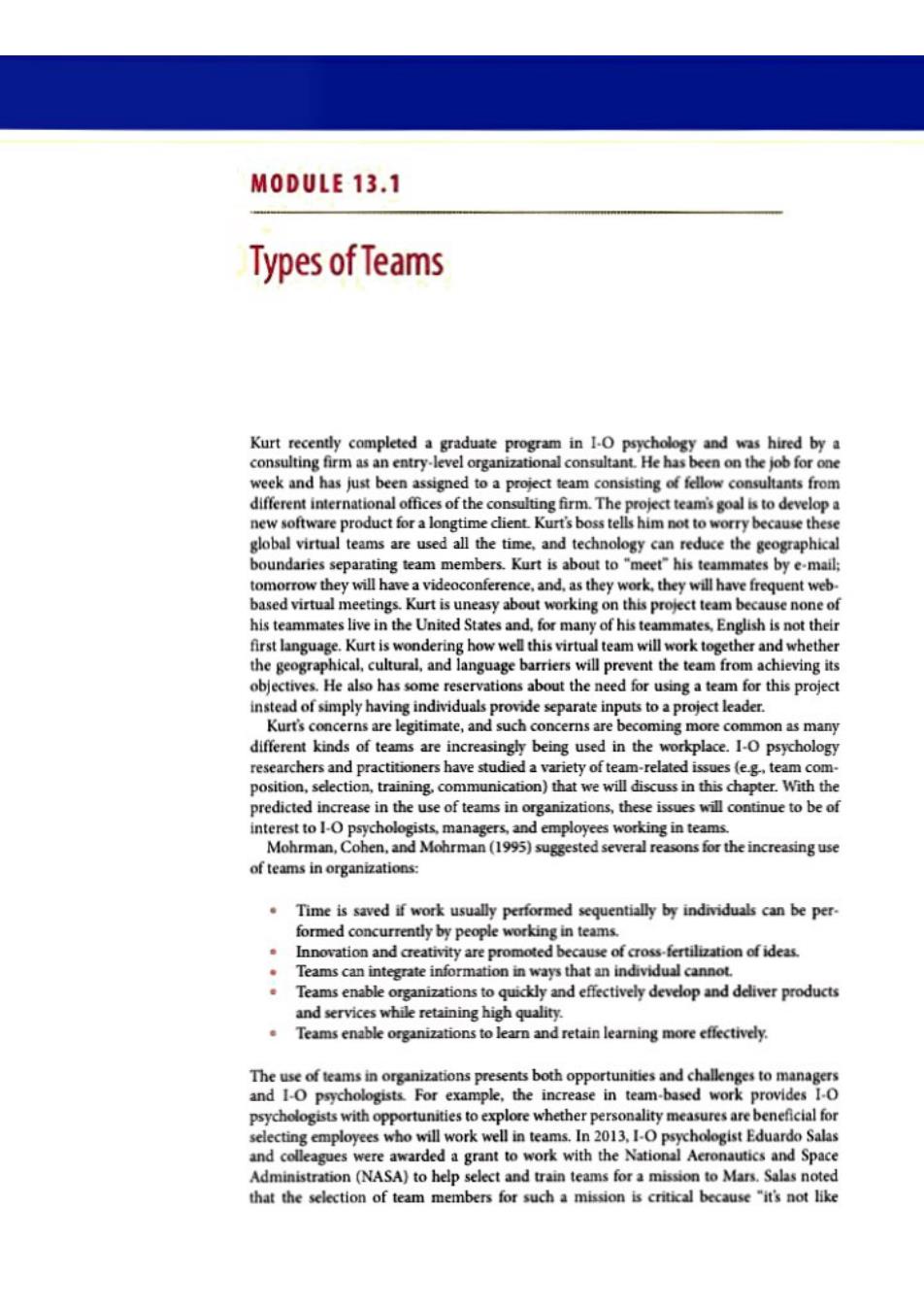
MODULE 13.1 Types of Teams Kurt recently completed a graduate program in I-0 psychology and was hired by a consulting firm as an entry-level organizational consultant.He has been on the job for one week and has just been assigned to a project team consisting of fellow consultants from different international offices of the consulting firm.The project team's goal is to develop a new software product for a longtime client.Kurt's boss tells him not to worry because these global virtual teams are used all the time.and technology can reduce the geographical boundaries separating team members.Kurt is about to "meet"his teammates by e-mail; tomorrow they will have a videoconference,and,as they work,they will have frequent web. based virtual meetings.Kurt is uneasy about working on this project team because none of his teammates live in the United States and,for many of his teammates,English is not their first language.Kurt is wondering how well this virtual team will work together and whether the geographical,cultural,and language barriers will prevent the team from achieving its objectives.He also has some reservations about the need for using a team for this project instead of simply having individuals provide separate inputs to a project leader. Kurt's concerns are legitimate,and such concerns are becoming more common as many different kinds of teams are increasingly being used in the workplace.I-0 psychology researchers and practitioners have studied a variety of team-related issues (eg.team com- position,selection,training.communication)that we will discuss in this chapter.With the predicted increase in the use of teams in organizations,these issues will continue to be of interest to 1-O psychologists,managers,and employees working in teams. Mohrman,Cohen,and Mohrman(1995)suggested several reasons for the increasing use of teams in organizations: Time is saved if work usually performed sequentially by individuals can be per. formed concurrently by people working in teams. Innovation and creativity are promoted because of cross-fertilization of ideas. Teams can integrate information in ways that an individual cannot. Teams enable organizations to quickly and effectively develop and deliver products and services while retaining high quality. Teams enable organizations to learn and retain learning more effectively. The use of teams in organizations presents both opportunities and challenges to managers and 1-0 psychologists.For example,the increase in team-based work provides I-O psychologists with opportunities to explore whether personality measures are beneficial for selecting employees who will work well in teams.In 2013,I-O psychologist Eduardo Salas and colleagues were awarded a grant to work with the National Aeronautics and Space Administration (NASA)to help select and train teams for a mission to Mars.Salas noted that the selection of team members for such a mission is critical because "it's not like
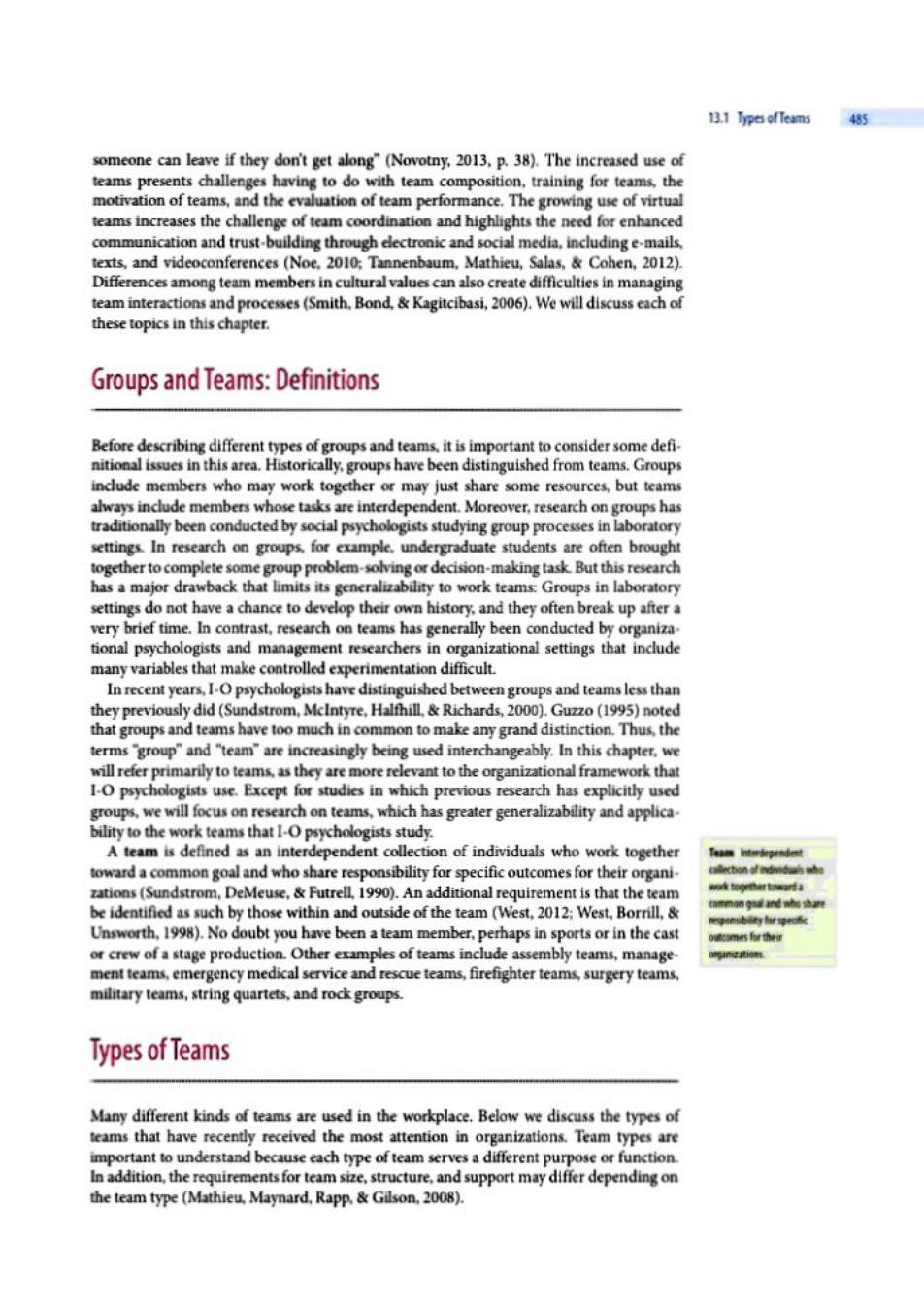
13.1 Types ofTeams 485 someone can leave if they don't get along"(Novotny,2013,p.38).The increased use of teams presents challenges having to do with team composition,training for teams,the motivation of teams,and the evaluation of team performance.The growing use of virtual teams increases the challenge of team coordination and highlights the need for enhanced communication and trust-building through electronic and social media,including e-mails. texts,and videoconferences (Noe,2010:Tannenbaum,Mathieu,Salas,Cohen,2012). Differences among team members in cultural values can also create difficulties in managing team interactions and processes(Smith.Bond,Kagitcibasi,2006).We will discuss each of these topics in this chapter. Groups and Teams:Definitions Before describing different types of groups and teams,it is important to consider some defi- nitional issues in this area.Historically,groups have been distinguished from teams.Groups include members who may work together or may just share some resources,but teams always include members whose tasks are interdependent.Moreover,research on groups has traditionally been conducted by social psychologists studying group processes in laboratory settings.In research on groups,for example,undergraduate students are often brought together to complete some group problem-solving or decision-making task But this research has a major drawback that limits its generalizability to work teams:Groups in laboratory settings do not have a chance to develop their own history.and they often break up after a very brief time.In contrast,research on teams has generally been conducted by organiza. tional psychologists and management researchers in organizational settings that include many variables that make controlled experimentation difficult. In recent years,I-O psychologists have distinguished between groups and teams less than they previously did(Sundstrom,Mclntyre.Halfhill,&Richards,2000).Guzzo(1995)noted that groups and teams have too much in common to make any grand distinction.Thus,the terms group"and "team"are increasingly being used interchangeably.In this chapter,we will refer primarily to teams,as they are more relevant to the organizational framework that 1-0 psychologists use.Except for studies in which previous research has explicitly used groups,we will focus on research on teams,which has greater generalizability and applica- bility to the work teams that I-O psychologists study. A team is defined as an interdependent collection of individuals who work together toward a common goal and who share responsibility for specific outcomes for their organi. zations (Sundstrom,DeMeuse,Futrell,1990).An additional requirement is that the team be identified as such by those within and outside of the team (West,2012:West,Borrill, mon and whe sha Unsworth,1998).No doubt you have been a team member,perhaps in sports or in the cast or crew of a stage production.Other examples of teams include assembly teams,manage. ment teams,emergency medical service and rescue teams,firefighter teams,surgery teams, military teams,string quartets,and rock groups. Types of Teams Many different kinds of teams are used in the workplace.Below we discuss the types of teams that have recently received the most attention in organizations.Team types are important to understand because each type of team serves a different purpose or function. In addition,the requirements for team size,structure,and support may differ depending on the team type (Mathieu,Maynard,Rapp,Gilson.2008)
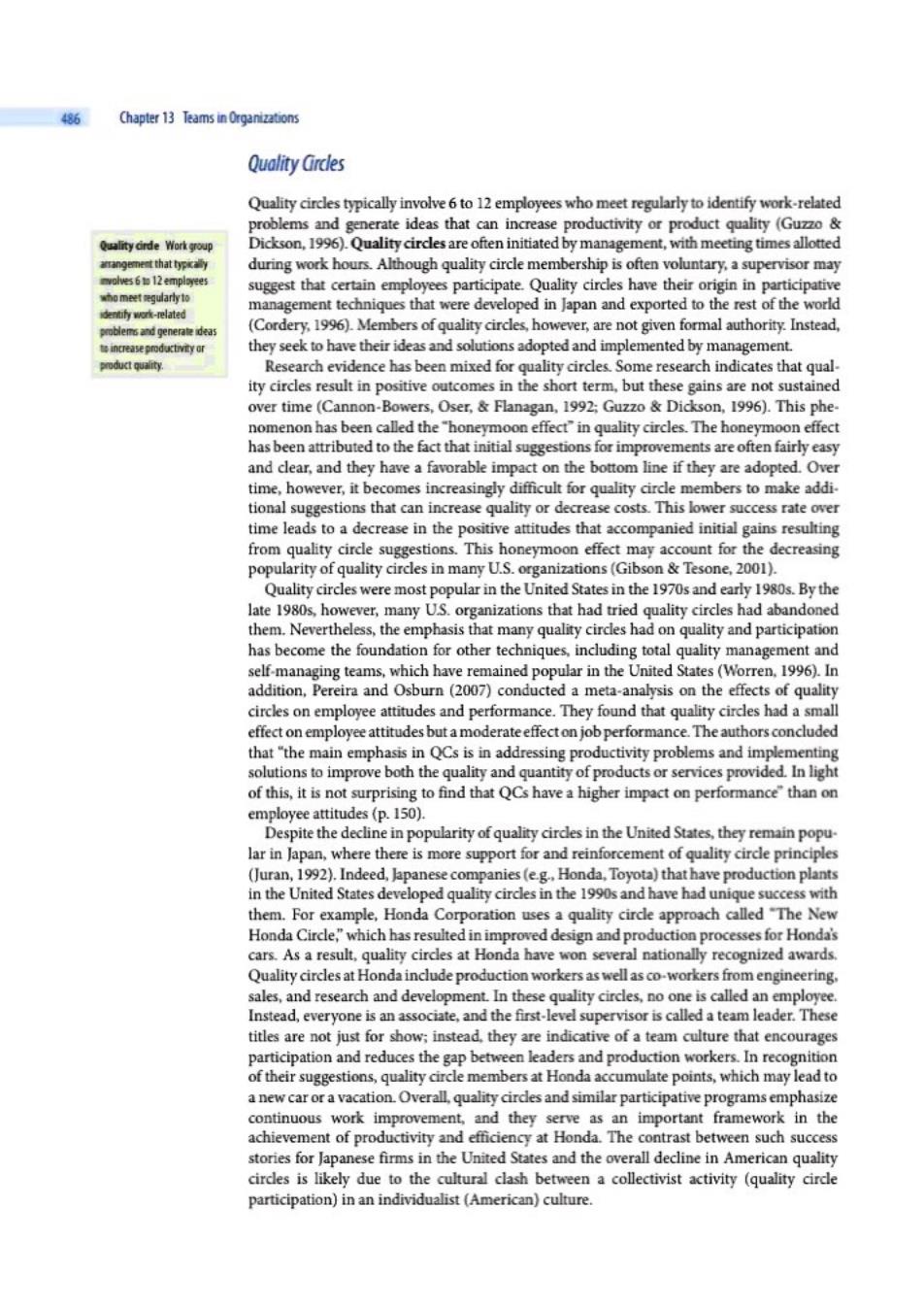
485 Chapter 13 Teams inOrganizations Quality Grcles Quality cirdles typically involve 6 to 12 employees who meet regularly to identify work-related problems and generate ideas that can increase productivity or product quality (Guzzo Quality drde Work group Dickson,1996).Quality circles are often initiated by management,with meeting times allotted angeme城that typically during work hours.Although quality circle membership is often voluntary.a supervisor may molves6l2empl与eegs suggest that certain employees participate.Quality circles have their origin in participative aome时gularly to deniy work-related management techniques that were developed in Japan and exported to the rest of the world blems and generate deas (Cordery,1996).Members of quality circles,however,are not given formal authority.Instead, increase productivty or they seek to have their ideas and solutions adopted and implemented by management. roduct quality. Research evidence has been mixed for quality circles.Some research indicates that qual. ity circles result in positive outcomes in the short term,but these gains are not sustained over time (Cannon-Bowers,Oser,Flanagan,1992;Guzzo Dickson,1996).This phe- nomenon has been called the "honeymoon effect"in quality circles.The honeymoon effect has been attributed to the fact that initial suggestions for improvements are often fairly easy and clear,and they have a favorable impact on the bottom line if they are adopted.Over time,however,it becomes increasingly difficult for quality circle members to make addi- tional suggestions that can increase quality or decrease costs.This lower success rate over time leads to a decrease in the positive attitudes that accompanied initial gains resulting from quality cirdle suggestions.This honeymoon effect may account for the decreasing popularity of quality circles in many U.S.organizations(Gibson Tesone,2001). Quality circles were most popular in the United States in the 1970s and early 1980s.By the late 1980s,however,many US.organizations that had tried quality circles had abandoned them.Nevertheless,the emphasis that many quality cirdes had on quality and participation has become the foundation for other techniques,including total quality management and self-managing teams,which have remained popular in the United States (Worren,1996).In addition,Pereira and Osburn (2007)conducted a meta-analysis on the effects of quality circles on employee attitudes and performance.They found that quality circles had a small effect on employee attitudes but a moderate effect on job performance.The authors concluded thatthe main emphasis in QCs is in addressing productivity problems and implementing solutions to improve both the quality and quantity of products or services provided.In light of this,it is not surprising to find that QCs have a higher impact on performance"than on employee attitudes (p.150). Despite the decline in popularity of quality cirdes in the United States,they remain popu- lar in Japan,where there is more support for and reinforcement of quality circle principles (Juran,1992).Indeed,Japanese companies(e.g.Honda,Toyota)that have production plants in the United States developed quality circles in the 1990s and have had unique success with them.For example,Honda Corporation uses a quality circle approach called"The New Honda Circle,which has resulted in improved design and production processes for Honda's cars.As a result,quality cirdles at Honda have won several nationally recognized awards. Quality circles at Honda include production workers as well as co-workers from engineering. sales,and research and development.In these quality circles,no one is called an employee. Instead,everyone is an associate,and the first-level supervisor is called a team leader.These titles are not just for show;instead,they are indicative of a team culture that encourages participation and reduces the gap between leaders and production workers.In recognition of their suggestions,quality circle members at Honda accumulate points,which may lead to a new car or a vacation.Overall,quality cirdes and similar participative programs emphasize continuous work improvement,and they serve as an important framework in the achievement of productivity and efficiency at Honda.The contrast between such success stories for Japanese firms in the United States and the overall decline in American quality cirdles is likely due to the cultural clash between a collectivist activity (quality circle participation)in an individualist (American)culture
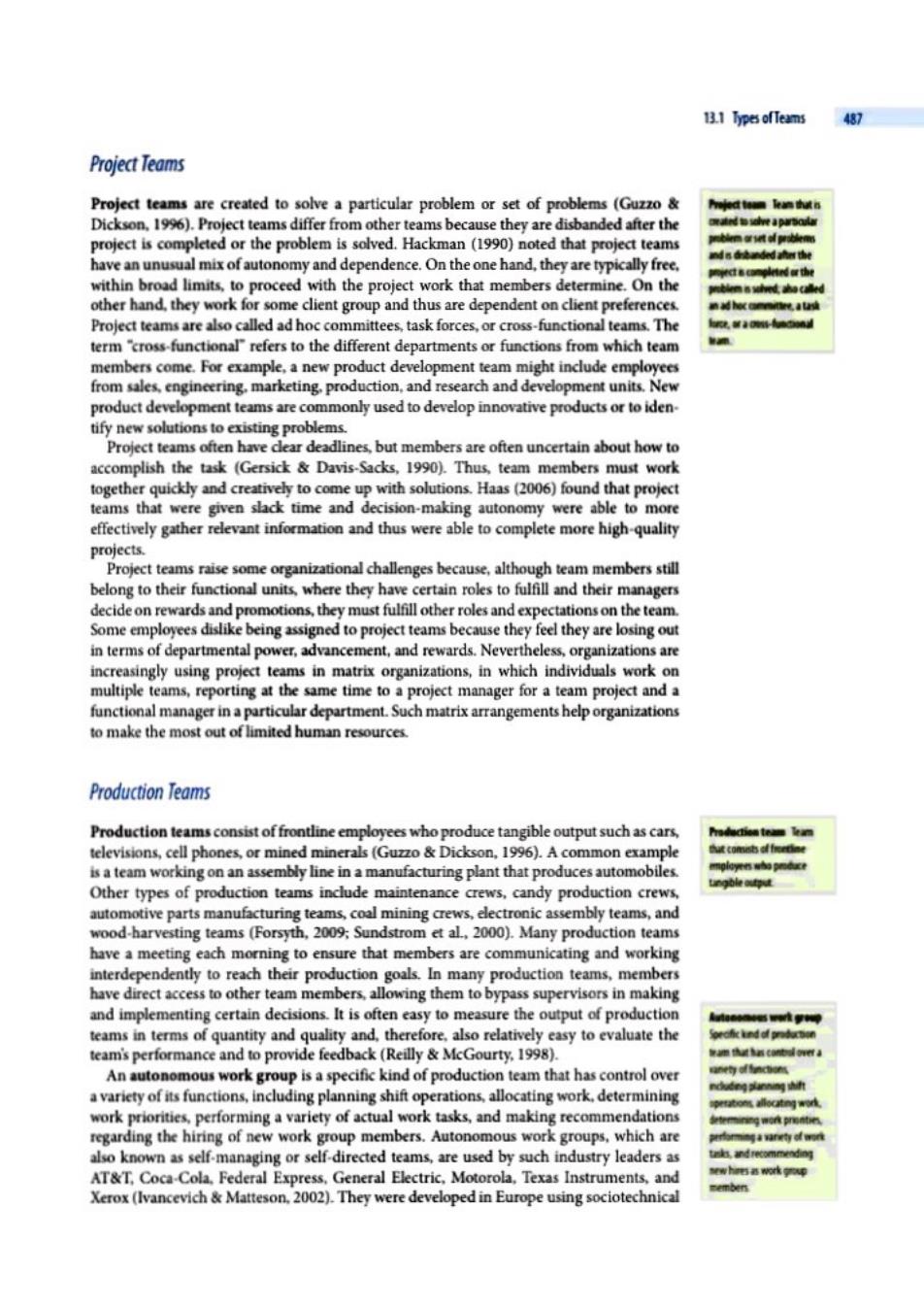
13.1 Types ofTeams 487 Project Teams Project teams are created to solve a particular problem or set of problems (Guzzo Dickson,1996).Project teams differ from other teams because they are disbanded after the project is completed or the problem is solved.Hackman (1990)noted that project teams ded the have an unusual mix of autonomy and dependence.On the one hand,they are typically free. within broad limits,to proceed with the project work that members determine.On the om nsived.she caled other hand,they work for some client group and thus are dependent on client preferences. 热转hem线aad Project teams are also called ad hoc committees,task forces,or cross-functional teams.The .oit-hnmona term cross-functional"refers to the different departments or functions from which team members come.For example,a new product development team might include employees from sales,engineering.marketing.production,and research and development units.New product development teams are commonly used to develop innovative products or to iden- tify new solutions to existing problems. Project teams often have dlear deadlines,but members are often uncertain about how to accomplish the task (Gersick Davis-Sacks,1990).Thus,team members must work together quickly and creatively to come up with solutions.Haas (2006)found that project teams that were given slack time and decision-making autonomy were able to more effectively gather relevant information and thus were able to complete more high-quality projects. Project teams raise some organizational challenges because,although team members still belong to their functional units,where they have certain roles to fulfill and their managers decide on rewards and promotions,they must fulfill other roles and expectations on the team. Some employees dislike being assigned to project teams because they feel they are losing out in terms of departmental power,advancement,and rewards.Nevertheless,organizations are increasingly using project teams in matrix organizations,in which individuals work on multiple teams,reporting at the same time to a project manager for a team project and a functional manager in a particular department.Such matrix arrangements help organizations to make the most out of limited human resources. Production Teams Production teams consist of frontline employees who produce tangible output such as cars, televisions,cell phones,or mined minerals(Guzzo Dickson,1996).A common example is a team working on an assembly line in a manufacturing plant that produces automobiles. Other types of production teams include maintenance crews,candy production crews, automotive parts manufacturing teams,coal mining crews,electronic assembly teams,and wood-harvesting teams(Forsyth,2009:Sundstrom et al,2000).Many production teams have a meeting each morning to ensure that members are communicating and working interdependently to reach their production goals.In many production teams,members have direct access to other team members,allowing them to bypass supervisors in making and implementing certain decisions.It is often easy to measure the output of production teams in terms of quantity and quality and,therefore.also relatively easy to evaluate the team's performance and to provide feedback(Reilly McGourty,1998). wam thae has cantsol over a An autonomous work group is a specific kind of production team that has control over e倚nc a variety of its functions,including planning shift operations,allocating work.determining work priorities,performing a variety of actual work tasks,and making recommendations regarding the hiring of new work group members.Autonomous work groups,which are also known as self-managing or self-directed teams,are used by such industry leaders as AT&T,Coca-Cola.Federal Express,General Electric,Motorola,Texas Instruments,and w西酒tae Xerox(lvancevich Matteson,2002).They were developed in Europe using sociotechnical
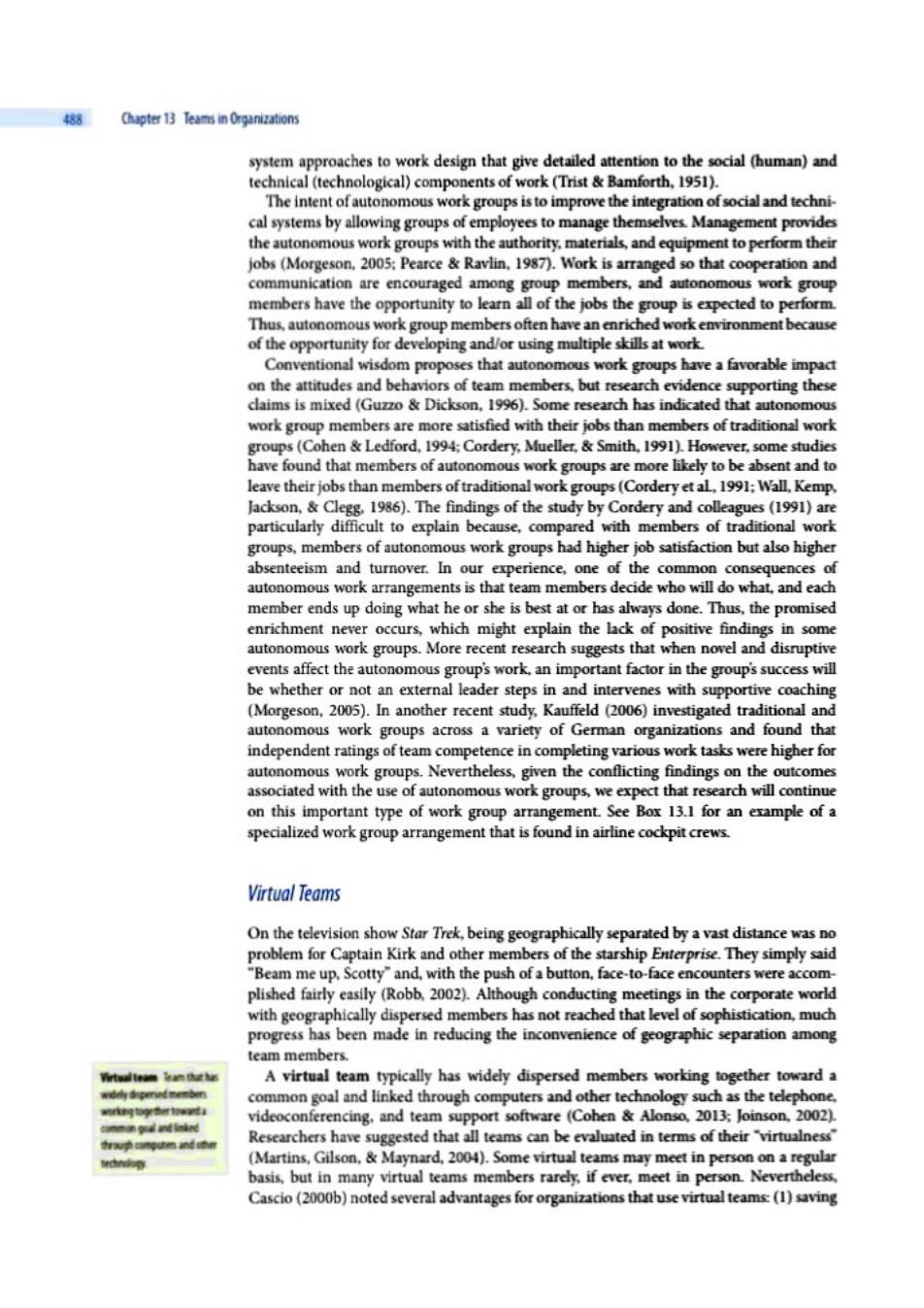
488 Chapter 13 Teams in Organizations system approaches to work design that give detailed attention to the social (human)and technical (technological)components of work(Trist Bamforth.1951). The intent of autonomous work groups is to improve the integration ofsocial and techni- cal systems by allowing groups of employees to manage themselves Management provides the autonomous work groups with the authority.materials,and equipment to perform their jobs (Morgeson,2005;Pearce Ravlin,1987).Work is arranged so that cooperation and communication are encouraged among group members,and autonomous work group members have the opportunity to learn all of the jobs the group is expected to perform. Thus,autonomous work group members often have an enriched work environment because of the opportunity for developing and/or using multiple skills at work. Conventional wisdom proposes that autonomous work groups have a favorable impact on the attitudes and behaviors of team members,but research evidence supporting these claims is mixed (Guzzo Dickson,1996).Some research has indicated that autonomous work group members are more satisfied with their jobs than members of traditional work groups(Cohen Ledford,1994;Cordery,Mueller,Smith,1991).However,some studies have found that members of autonomous work groups are more likely to be absent and to leave their jobs than members oftraditional work groups(Cordery et al,1991:Wall,Kemp. Jackson,Clegg.1986).The findings of the study by Cordery and colleagues (1991)are particularly difficult to explain because,compared with members of traditional work groups,members of autonomous work groups had higher job satisfaction but also higher absenteeism and turnover.In our experience,one of the common consequences of autonomous work arrangements is that team members decide who will do what,and each member ends up doing what he or she is best at or has always done.Thus,the promised enrichment never occurs,which might explain the lack of positive findings in some autonomous work groups.More recent research suggests that when novel and disruptive events affect the autonomous group's work.an important factor in the group's success will be whether or not an external leader steps in and intervenes with supportive coaching (Morgeson,2005).In another recent study.Kauffeld (2006)investigated traditional and autonomous work groups across a variety of German organizations and found that independent ratings of team competence in completing various work tasks were higher for autonomous work groups.Nevertheless,given the conflicting findings on the outcomes associated with the use of autonomous work groups,we expect that research will continue on this important type of work group arrangement.See Box 13.1 for an example of a specialized work group arrangement that is found in airline cockpit crews. Virtual Teams On the television show Star Trek,being geographically separated by a vast distance was no problem for Captain Kirk and other members of the starship Enterprise.They simply said "Beam me up,Scotty"and,with the push of a button,face-to-face encounters were accom- plished fairly easily (Robb,2002).Although conducting meetings in the corporate world with geographically dispersed members has not reached that level of sophistication,much progress has been made in reducing the inconvenience of geographic separation among team members. A virtual team typically has widely dispersed members working together toward a common goal and linked through computers and other technology such as the telephone. videoconferencing.and team support software (Cohen Alonso,2013:Joinson.2002). Researchers have suggested that all teams can be evaluated in terms of their virtualness" (Martins,Gilson,Maynard,2004).Some virtual teams may meet in person on a regular basis.but in many virtual teams members rarely,if ever,meet in person.Nevertheless. Cascio(2000b)noted several advantages for organizations that use virtual teams:(1)saving

13.1 Types ofTeams 489 BON 13.T A SPECIALIZED TEAMT AIRLINE COCKPIT CREW More than a century after the Wright brothers was crippled by the loss of both engines.By all worked as a team to achieve the first recorded accounts,the five-member crew (two in the cockpit flight(December 17.1903).teamwork in aviation and three in the cabin)performed complex tasks in is still a maior concern (Brannick.Prince.Salas. an integrated manner that resulted in the safe exit 2005:Salas.Burke.Bowers,Wilson.2001). of all 150 passengers and the crew without loss of Airline cockpit crews perform highly interdepen. life or serious injury.Notably.the pilot,Captain dent tasks.some that occur routinely in all flights Chesley"Sully"Sullenberger,has a master's degree and others that may occur only in rare but well- in I-O psychology and is professionally involved in practiced emergency situations (Ginnett.1990). crew resource management research and training. Cockpit crews are unique in that they work According to Ginnett(1990).crews benefit from together for a brief time and must effectively per- an organizational context that provides the follow. form critical tasks soon after the crew is formed. ing components: Newly formed crews are able to perform effectively soon after they meet because crew members Challenging objectives for safety,on-time receive extensive training that precedes their work performance.and fuel efficiency on a particular crew. An educational system that provides train. Airline cockpit crews rarely run into problems. ing and consultation to supplement mem. but the real requirements for effective teamwork bers'task expertise occur when they do.A spectacular example is the An information system that provides the Hudson River landing of US Airways flight 1549 in data needed to assess situations and evaluate lanuary 2009.Moments after take-off,the airplane alternative strategies for handling them When US Ainways flight 1549 had to make an emergency landing in the Hudson River. the crew performed complex tasks in an integrated manner that resulted in the safe exit of all 150 passengers and the crew. (Continued)
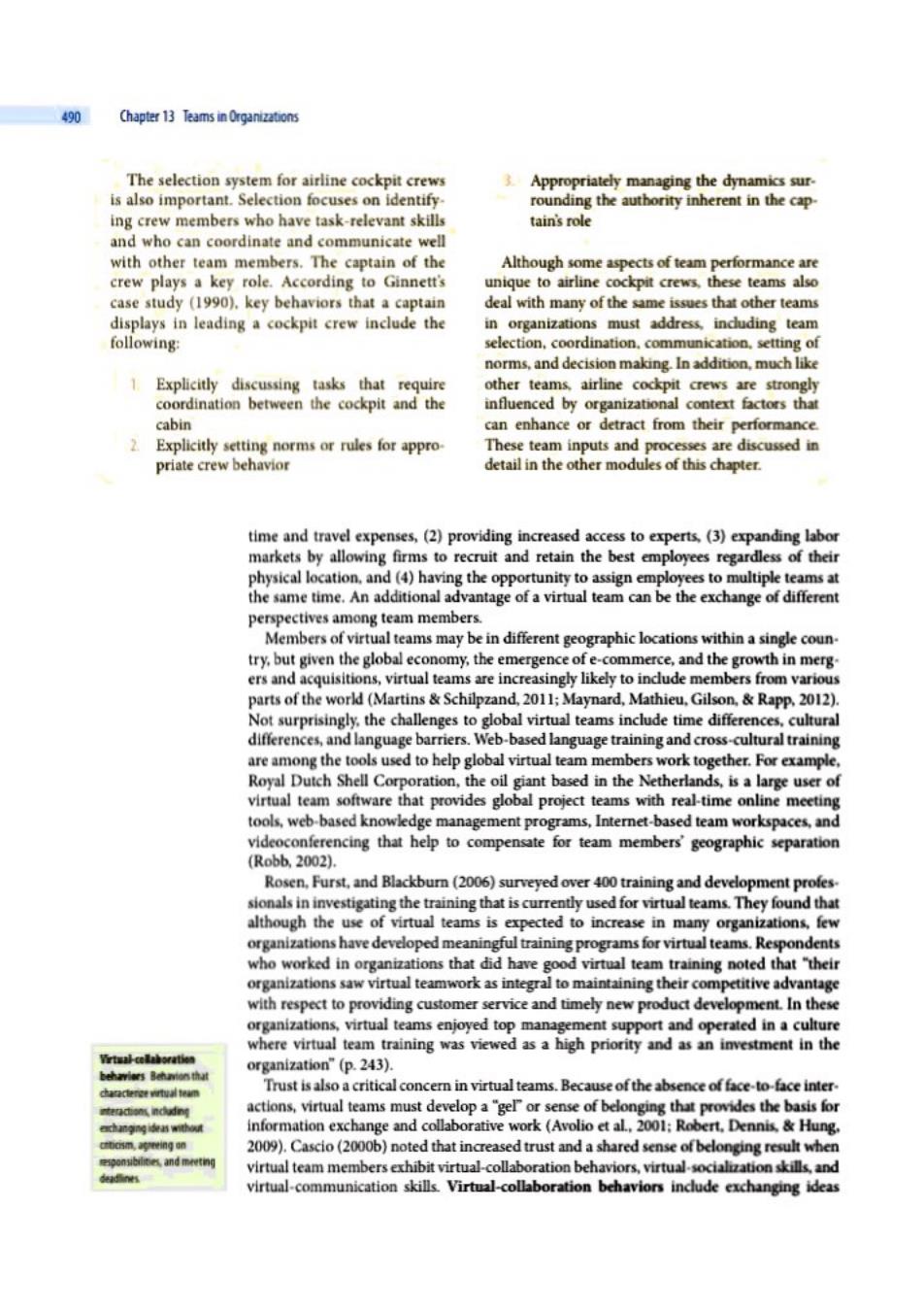
490 Chapter 13 Teams in Organizations The selection system for airline cockpit crews Appropriately managing the dynamics sur. is also important.Selection focuses on identify- rounding the authority inherent in the cap. ing crew members who have task-relevant skills tain's role and who can coordinate and communicate well with other team members.The captain of the Although some aspects of team performance are crew plays a key role.According to Ginnett's unique to airline cockpit crews,these teams also case study (1990).key behaviors that a captain deal with many of the same issues that other teams displays in leading a cockpit crew include the in organizations must address,induding team following: selection,coordination.communication.setting of norms,and decision making In addition,much like 1 Explicitly discussing tasks that require other teams.airline cockpit crews are strongly coordination between the cockpit and the influenced by organizational context factors that cabin can enhance or detract from their performance 2 Explicitly setting norms or rules for appro- These team inputs and processes are discussed in priate crew behavior detail in the other modules of this chapter. time and travel expenses,(2)providing increased access to experts.(3)expanding labor markets by allowing firms to recruit and retain the best employees regardless of their physical location.and (4)having the opportunity to assign employees to multiple teams at the same time.An additional advantage of a virtual team can be the exchange of different perspectives among team members. Members of virtual teams may be in different geographic locations within a single coun. try,but given the global economy,the emergence of e-commerce,and the growth in merg ers and acquisitions,virtual teams are increasingly likely to indlude members from various parts of the world (Martins Schilpzand,2011;Maynard,Mathieu,Gilson,Rapp,2012). Not surprisingly,the challenges to global virtual teams include time differences,cultural differences,and language barriers.Web-based language training and cross-cultural training are among the tools used to help global virtual team members work together.For example, Royal Dutch Shell Corporation,the oil giant based in the Netherlands,is a large user of virtual team software that provides global project teams with real-time online meeting tools,web-based knowledge management programs,Internet-based team workspaces,and videoconferencing that help to compensate for team members'geographic separation (Robb.2002). Rosen,Furst,and Blackburn(2006)surveyed over 400 training and development profes. sionals in investigating the training that is currently used for virtual teams.They found that although the use of virtual teams is expected to increase in many organizations,few organizations have developed meaningful training programs for virtual teams.Respondents who worked in organizations that did have good virtual team training noted that "their organizations saw virtual teamwork as integral to maintaining their competitive advantage with respect to providing customer service and timely new product development.In these organizations,virtual teams enjoyed top management support and operated in a culture where virtual team training was viewed as a high priority and as an investment in the Virtsal-celahoration organization"(p.243). Trust is also a critical concern in virtual teams.Because of the absence of face-to-face inter- actions,virtual teams must develop agel or sense of belonging that provides the basis for information exchange and collaborative work (Avolio et al.,2001;Robert,Dennis,Hung. 2009).Cascio(2000b)noted that increased trust and a shared sense ofbelonging result when t线and meetin virtual team members exhibit virtual-collaboration behaviors,virtual-socialization skills,and virtual-communication skills.Virtual-collaboration behaviors include exchanging ideas
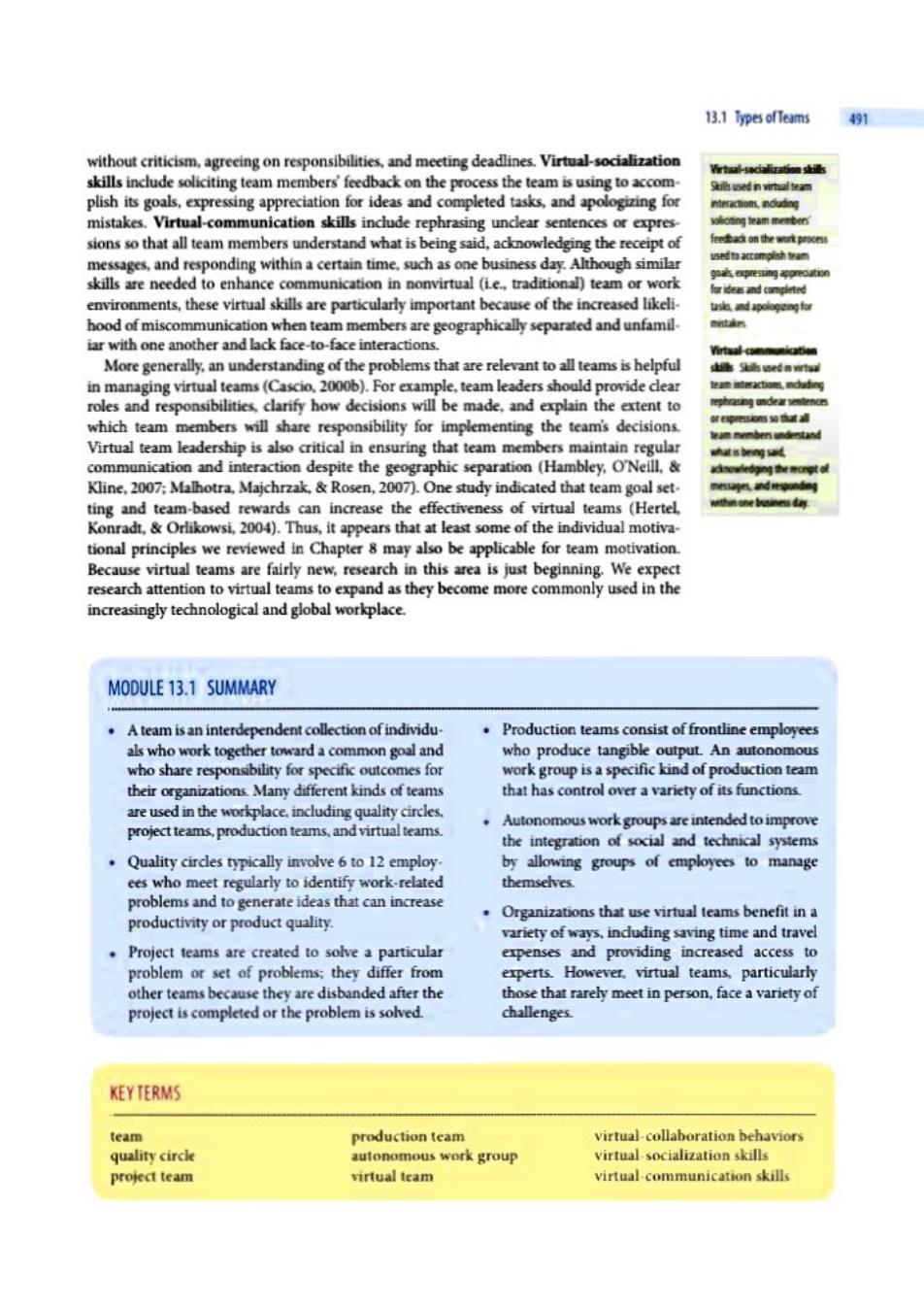
13.1 Types ofTeams 491 without criticism,agreeing on responsibilities,and meeting deadlines.Virtual-socialization 指tal-seciafin5e通 skills include soliciting team members'feedback on the process the team is using to accom- Skilk ued n virtual team plish its goals,expressing appreciation for ideas and completed tasks,and apologizing for mistakes.Virtual-communication skills indude rephrasing undear sentences or expres- sions so that all team members understand what is being said,acknowledging the receipt of ee士adk on the wurk pro messages,and responding within a certain time,such as one business day.Although similar skills are needed to enhance communication in nonvirtual (ie..traditional)team or work for ideas and completed environments,these virtual skills are particularly important because of the increased likeli. 如地d娘o国a hood of miscommunication when team members are geographically separated and unfamil. iar with one another and lack face-to-face interactions. rtul cmmlot心ee More generally,an understanding of the problems that are relevant to all teams is helpful 山i Skis ued n wrtua in managing virtual teams(Cascio,2000b).For example.team leaders should provide clear roles and responsibilities,clarify how decisions will be made,and explain the extent to which team members will share responsibility for implementing the team's decisions. Virtual team leadership is also critical in ensuring that team members maintain regular communication and interaction despite the geographic separation (Hambley.O'Neill, Kline,2007:Malhotra,Majchrzak,Rosen,2007).One study indicated that team goal set. ting and team-based rewards can increase the effectiveness of virtual teams(Hertel. Konradt,Orlikowsi,2004).Thus,it appears that at least some of the individual motiva- tional principles we reviewed in Chapter 8 may also be applicable for team motivation. Because virtual teams are fairly new,research in this area is just beginning.We expect research attention to virtual teams to expand as they become more commonly used in the increasingly technological and global workplace. MODULE 13.1 SUMMARY A team is an interdependent collection of individu- Production teams consist of frontline employees als who work together toward a common goal and who produce tangible output.An autonomous who share responsibility for specific outcomes for work group is a specific kind of production team their organizations Many different kinds of teams that has control over a variety of its functions. are used in the workplace.including quality circles. project teams.production teams,and virtual teams. Autonomous work groups are intended to improve the integration of social and technical systems Quality cirdes typically involve 6 to 12 employ. by allowing groups of employees to manage ees who meet regularly to identify work-related themselves problems and to generate ideas that can increase productivity or product quality. .Organizations that use virtual teams benefit in a variety of ways,induding saving time and travel Project teams are created to solve a particular expenses and providing increased access to problem or set of problems:they differ from experts.However.virtual teams.particularly other teams because they are disbanded after the those that rarely meet in person,face a variety of project is completed or the problem is solved. challenges KEY TERMS team production team virtual-collaboration behaviors quality circle autonomous work group virtual-socialization skills project team virtual team virtual-communication skills
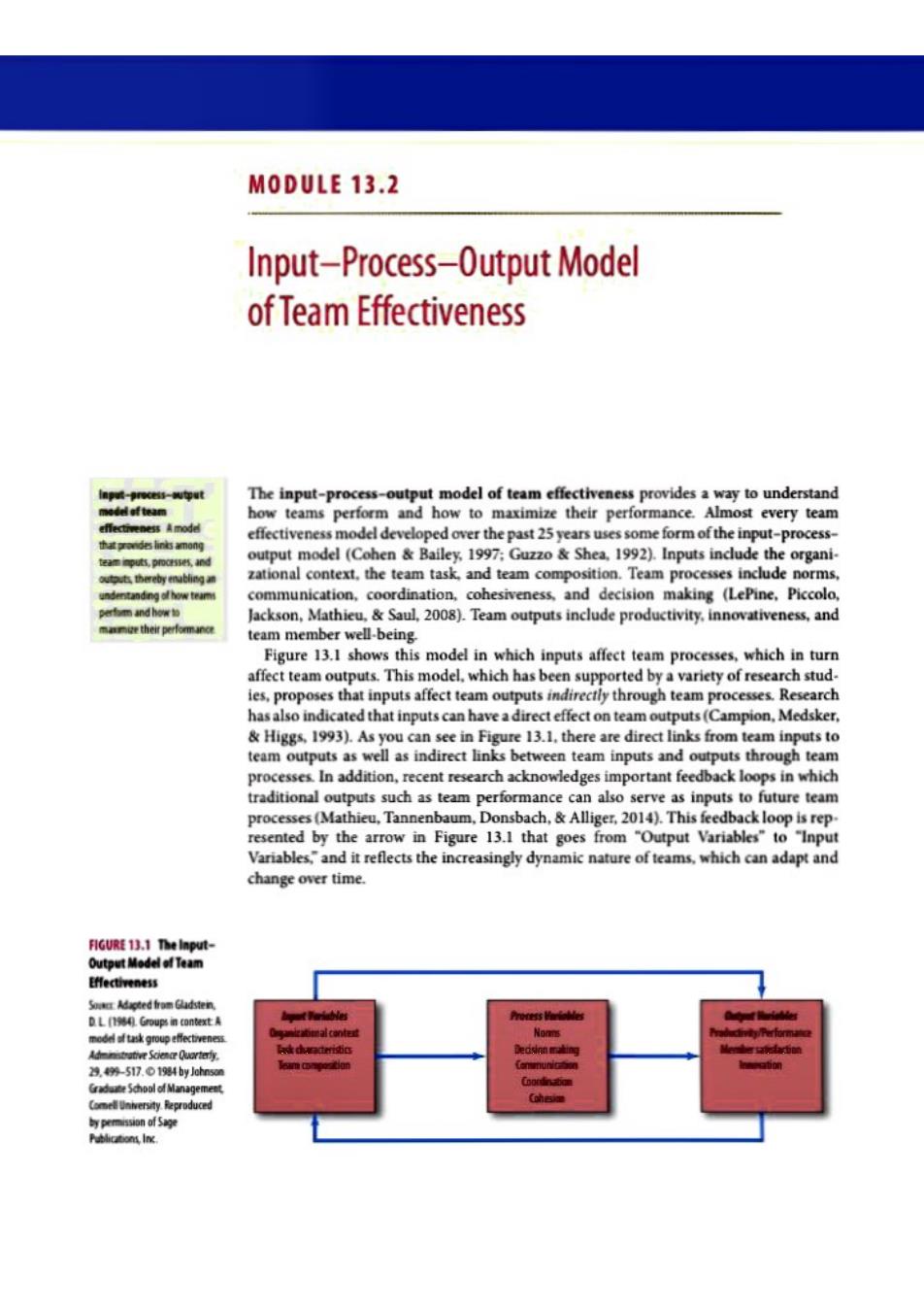
MODULE 13.2 Input-Process-Output Model of Team Effectiveness p-eci-年ut The input-process-output model of team effectiveness provides a way to understand model of team how teams perform and how to maximize their performance.Almost every team effectiveness model developed over the past 25 years uses some form of the input-process- team inputs,processes,and output model(Cohen Bailey.1997:Guzzo Shea.1992).Inputs include the organi- 中在hwbt铺向播 zational context.the team task.and team composition.Team processes include norms. andentanding of how teamt communication.coordination.cohesiveness,and decision making (LePine,Piccolo, erfam and howto Jackson,Mathieu,Saul,2008).Team outputs include productivity.innovativeness,and team member well-being Figure 13.1 shows this model in which inputs affect team processes,which in turn affect team outputs.This model.which has been supported by a variety of research stud. ies,proposes that inputs affect team outputs indirectly through team processes.Research has also indicated that inputs can have a direct effect on team outputs (Campion.Medsker. Higgs,1993).As you can see in Figure 13.1.there are direct links from team inputs to team outputs as well as indirect links between team inputs and outputs through team processes.In addition,recent research acknowledges important feedback loops in which traditional outputs such as team performance can also serve as inputs to future team processes (Mathieu,Tannenbaum,Donsbach,Alliger,2014).This feedback loop is rep. resented by the arrow in Figure 13.1 that goes from "Output Variables"to "Input Variables."and it reflects the increasingly dynamic nature of teams.which can adapt and change over time. FIGURE 13.1 The input- Outp据Model of Team Efectiveness Souer Adacted fram G仙dten DLt满线.Groups in contextA model f task group effectiveness Adtive Scien Quarterly. 2线w-5I7.019g4 by Jahnson Gradae School of Management Comel University.Reproduced 与pemission of5球